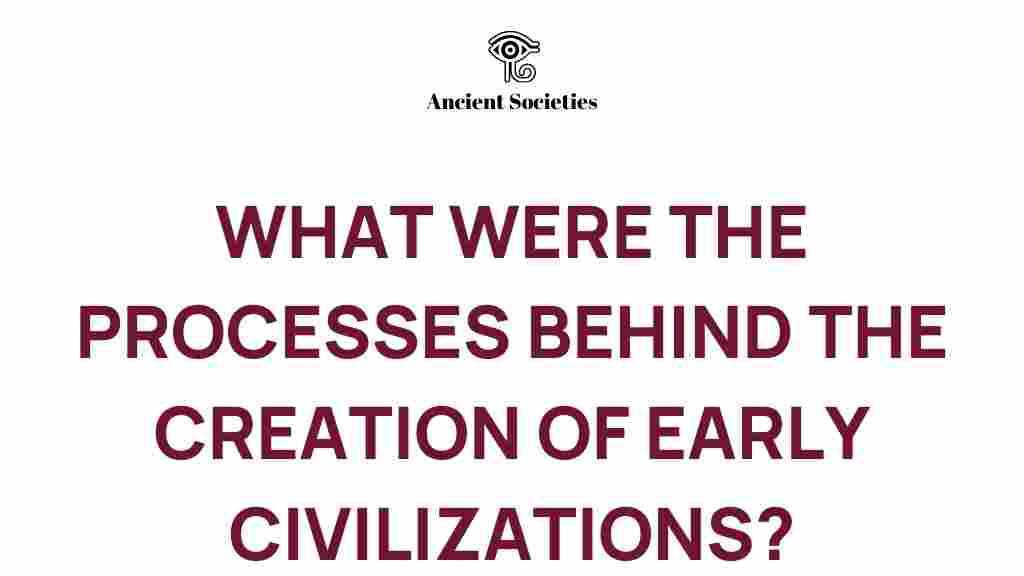Unveiling the Secrets: How Early Civilizations Came to Be
The journey of humanity from nomadic tribes to complex societies is a fascinating tale of early civilizations. These ancient societies laid the groundwork for modern culture, governance, and technological advancements. Understanding the processes that led to the formation of civilizations allows us to appreciate the ingenuity that drives human progress. In this article, we will explore the steps involved in the emergence of early civilizations, the factors influencing their development, and the archaeological findings that illuminate our past.
The Foundations of Civilization Formation
The formation of civilizations is not a straightforward process; rather, it is a complex interplay of various factors. Here are the key components that contributed to the rise of early civilizations:
- Agricultural Revolution: The shift from hunting and gathering to agriculture allowed societies to settle in one place, leading to surplus food production.
- Geographical Advantages: Proximity to water sources like rivers facilitated irrigation, trade, and transport, crucial for societal growth.
- Social Structure: As populations grew, social hierarchies emerged, creating roles and responsibilities that organized communities.
- Technological Innovations: Innovations in tools and techniques enabled more efficient farming and construction, boosting productivity.
- Trade Networks: The exchange of goods and ideas with neighboring groups fostered cultural development and economic prosperity.
Step-by-Step Process of Civilization Formation
The transition from small, nomadic groups to established ancient societies involved several crucial stages:
1. Nomadic Lifestyle to Settled Farming
The first step was the transition from a nomadic lifestyle to settled farming. This significant change, known as the Neolithic Revolution, allowed communities to cultivate crops and domesticate animals. This shift provided a stable food supply, enabling population growth.
2. Establishing Permanent Settlements
With a steady food supply, people began to build permanent homes and villages. This led to the establishment of social structures and the need for governance. Settlements often arose near rivers or fertile land, which were crucial for agriculture.
3. Development of Social Hierarchies
As populations grew, so did the complexity of social interactions. Leaders emerged, often based on wealth or military prowess. This led to the creation of distinct social classes, with roles that included farmers, artisans, and rulers.
4. Creation of Writing Systems
The need for record-keeping and communication gave rise to writing systems. Early forms of writing, like cuneiform in Mesopotamia and hieroglyphics in Egypt, were essential for trade, governance, and cultural expression.
5. Advancements in Technology and Craftsmanship
Technological innovations, such as the wheel and metallurgy, played vital roles in the development of early civilizations. These advancements improved transportation and tool-making, enhancing productivity and trade.
6. Establishment of Trade Networks
As ancient societies flourished, trade networks expanded. This not only allowed for the exchange of goods but also facilitated the sharing of ideas and cultural practices, influencing societal evolution.
7. Formation of Religious and Cultural Institutions
Religion became a unifying force within these early societies. Temples and religious leaders played significant roles in governance and social cohesion, underscoring the importance of shared beliefs in civilization formation.
Archaeological Insights into Early Civilizations
The study of archaeology provides invaluable insights into the lives of early civilizations. Excavations of ancient sites reveal artifacts, structures, and even remnants of early human behavior. Key archaeological findings include:
- Mesopotamia: The cradle of civilization, home to the Sumerians, who developed one of the first writing systems and urban centers.
- Egypt: Known for its monumental architecture, including the pyramids, which reflect advanced engineering skills and a complex social structure.
- Indus Valley: Characterized by well-planned cities like Mohenjo-Daro, showcasing sophisticated urban planning and drainage systems.
- China: The Shang Dynasty established one of the earliest known Chinese civilizations, marked by advances in bronze metallurgy and writing.
Human Ingenuity in Cultural Development
Human ingenuity has been a driving force in the evolution of ancient societies. The ability to innovate and adapt to changing environments has allowed civilizations to thrive. Some key aspects of this ingenuity include:
- Art and Architecture: Creative expression through art, sculpture, and monumental buildings reflects cultural values and technological prowess.
- Scientific Advancements: Early civilizations made significant contributions to mathematics, astronomy, and medicine, laying the groundwork for future discoveries.
- Legal Systems: The establishment of laws and governance structures reflects the need for order and justice in growing societies.
Troubleshooting the Misconceptions about Early Civilizations
Despite extensive research, misconceptions about early civilizations persist. Here are some common misunderstandings and clarifications:
- Myth: Civilizations emerged suddenly.
Reality: The formation of civilizations was a gradual process influenced by various factors over centuries. - Myth: All ancient societies were similar.
Reality: Each civilization developed uniquely based on geography, resources, and cultural interactions. - Myth: Only large civilizations were significant.
Reality: Smaller societies and tribes also contributed to cultural development and technological advancements.
Conclusion: The Legacy of Early Civilizations
The study of early civilizations reveals a rich tapestry of human history marked by creativity, resilience, and adaptability. From the rise of agriculture to the establishment of complex societies, these historical processes have shaped our world today. Understanding the evolution of ancient societies helps us appreciate our cultural heritage and the ingenuity that continues to drive human progress.
For those interested in delving deeper into the fascinating world of early civilizations, resources such as historical databases and archaeological journals offer a wealth of information. By exploring these resources, we can unveil more secrets of our past and understand the remarkable journey of human civilization.
This article is in the category History and created by AncientSocieties Team
